Maximizing Common Bean (Phaseolus vulgaris L.) Productivity Through Application of Organic and Inorganic Fertilizers in Alkaline Soil
Abstract
1. Introduction
2. Materials and Methods
2.1. Experimental Design and Site Description
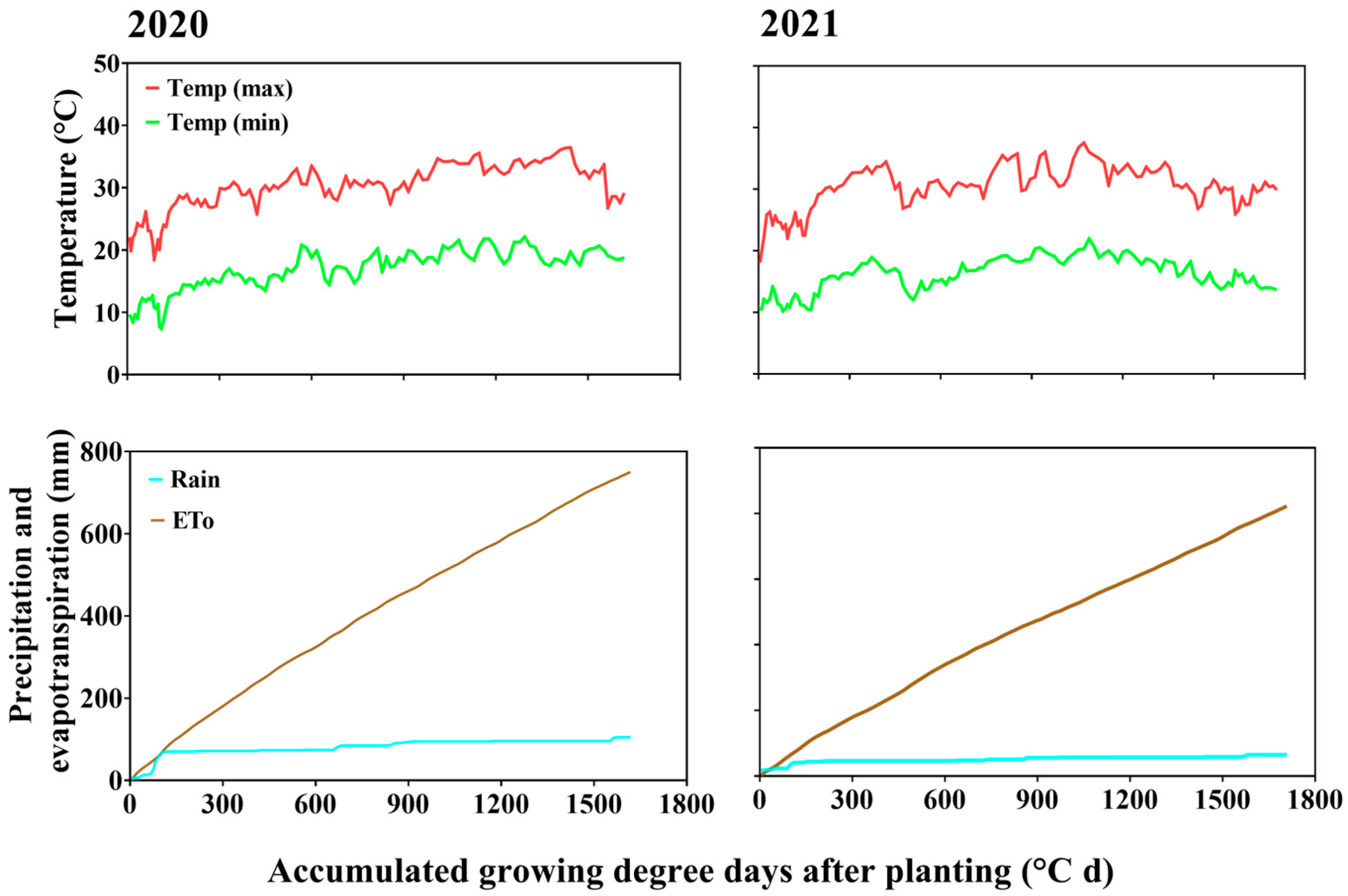
2.2. Data Collection
2.3. Statistical Analysis
3. Results
3.1. Impact of Combined Fertilizers on Growth Attributes
3.2. Effect of Integrated Fertilizers on Yield and Yield Components
3.3. Correlations of Growth and Yield Parameters
4. Discussion
5. Conclusions
Author Contributions
Funding
Institutional Review Board Statement
Informed Consent Statement
Data Availability Statement
Conflicts of Interest
References
- Al-Amri, S.M. Application of Bio-Fertilizers for Enhancing Growth and Yield of Common Bean Plants Grown under Water Stress Conditions. Saudi J. Biol. Sci. 2021, 28, 3901–3908. [Google Scholar] [CrossRef] [PubMed]
- Bamber, N.; Arulnathan, V.; Puddu, L.; Smart, A.; Ferdous, J.; Pelletier, N. Life Cycle Inventory and Assessment of Canadian Faba Bean and Dry Bean Production. Sustain. Prod. Consum. 2024, 46, 442–459. [Google Scholar] [CrossRef]
- Horácio, E.H.; Zambrano Gavilanes, F.E.; Feliciano, M.V.; de Moraes, J.G.; Zucareli, C.; Andrade, D.S.; Maddela, N.R.; Prasad, R. Exploring the Interaction Effects between Common Bean Cultivars and Rhizobia Inoculation on Plant Growth and Yield. J. Agric. Food Res. 2024, 15, 100926. [Google Scholar] [CrossRef]
- Degu, T.; Alemu, T.; Desalegn, A.; Amsalu, B.; Assefa, A. Association of Cropping Practices, Cropping Areas, and Foliar Diseases of Common Bean (Phaseolus vulgaris L.) in Ethiopia. J. Agric. Food Res. 2023, 14, 100765. [Google Scholar] [CrossRef]
- Shi, Z.; Blecker, C.; Richel, A.; Wei, Z.; Chen, J.; Ren, G.; Guo, D.; Yao, Y.; Haubruge, E. Three-Dimensional (3D) Printability Assessment of Food-Ink Systems with Superfine Ground White Common Bean (Phaseolus vulgaris L.) Protein Based on Different 3D Food Printers. LWT 2022, 155, 112906. [Google Scholar] [CrossRef]
- Paula, L.C.; Lemes, A.C.; Valencia-Mejía, E.; Moreira, B.R.; Oliveira, T.S.; Campos, I.T.N.; Neri, H.F.S.; Brondani, C.; Ghedini, P.C.; Batista, K.A.; et al. Effect of Extrusion and Autoclaving on the Biological Potential of Proteins and Naturally-Occurring Peptides from Common Beans: Antioxidant and Vasorelaxant Properties. Food Chem. X 2022, 13, 100259. [Google Scholar] [CrossRef]
- Hussain, S.; Malakar, S.; Arora, V.K. Extrusion-Based 3D Food Printing: Technological Approaches, Material Characteristics, Printing Stability, and Post-Processing. Food Eng. Rev. 2022, 14, 100–119. [Google Scholar] [CrossRef]
- Shumi, D. Response of Common Bean (Phaseolus vulgaris L.) Varieties to Rates of Blended NPS Fertilizer in Adola District, Southern Ethiopia. Afr. J. Plant Sci. 2018, 12, 164–179. [Google Scholar] [CrossRef]
- Etana, D.; Nebiyu, A. Response of Common Bean (Phaseolus vulgaris L.) to Lime and TSP Fertilizer under Acid Soil. Heliyon 2023, 9, e15176. [Google Scholar] [CrossRef]
- Rurangwa, E.; Vanlauwe, B.; Giller, K.E. Agriculture, Ecosystems and Environment Bene Fi Ts of Inoculation, P Fertilizer and Manure on Yields of Common Bean and Soybean Also Increase Yield of Subsequent Maize. Agric. Ecosyst. Environ. 2018, 261, 219–229. [Google Scholar] [CrossRef]
- Polania, J.; Poschenrieder, C.; Rao, I.; Beebe, S. Estimation of Phenotypic Variability in Symbiotic Nitrogen Fixation Ability of Common Bean under Drought Stress Using 15N Natural Abundance in Grain. Eur. J. Agron. 2016, 79, 66–73. [Google Scholar] [CrossRef] [PubMed]
- Hirsch, A.M.; Lum, M.R.; Downie, J.A. What Makes the Rhizobia-Legume Symbiosis so Special? Plant Physiol. 2001, 127, 1484–1492. [Google Scholar] [CrossRef] [PubMed]
- Bustos-Segura, C.; Godschalx, A.L.; Malacari, L.; Deiss, F.; Rasmann, S.; Ballhorn, D.J.; Benrey, B. Rhizobia-Legume Symbiosis Mediates Direct and Indirect Interactions between Plants, Herbivores and Their Parasitoids. Heliyon 2024, 10, e27815. [Google Scholar] [CrossRef]
- Liu, L.; Knight, J.D.; Lemke, R.L.; Farrell, R.E. Quantifying the Contribution of Above- and below-Ground Residues of Chickpea, Faba Bean, Lentil, Field Pea and Wheat to the Nitrogen Nutrition of a Subsequent Wheat Crop. Field Crops Res. 2024, 313, 109412. [Google Scholar] [CrossRef]
- Nadeem Shah, M.; Wright, D.L.; Hussain, S.; Koutroubas, S.D.; Seepaul, R.; George, S.; Ali, S.; Naveed, M.; Khan, M.; Tanveer Altaf, M.; et al. Organic Fertilizer Sources Improve the Yield and Quality Attributes of Maize (Zea mays L.) Hybrids by Improving Soil Properties and Nutrient Uptake under Drought Stress. J. King Saud. Univ. Sci. 2023, 35, 102570. [Google Scholar] [CrossRef]
- Li, L.; Jia, R.; Qu, Z.; Li, T.; Shen, W.; Qu, D. Coupling between Nitrogen-Fixing and Iron (III)-Reducing Bacteria as Revealed by the Metabolically Active Bacterial Community in Flooded Paddy Soils Amended with Glucose. Sci. Total Environ. 2020, 716, 137056. [Google Scholar] [CrossRef] [PubMed]
- Yang, X.; Xiong, J.; Du, T.; Ju, X.; Gan, Y.; Li, S.; Xia, L.; Shen, Y.; Pacenka, S.; Steenhuis, T.S.; et al. Diversifying Crop Rotation Increases Food Production, Reduces Net Greenhouse Gas Emissions and Improves Soil Health. Nat. Commun. 2024, 15, 198. [Google Scholar] [CrossRef]
- Ayilara, M.S.; Abberton, M.; Oyatomi, O.A.; Odeyemi, O.; Babalola, O.O. Potentials of Underutilized Legumes in Food Security. Front. Soil. Sci. 2022, 2, 1020193. [Google Scholar] [CrossRef]
- Das, A.; Ghosh, P.K. Role of Legumes in Sustainable Agriculture and Food Security: An Indian Perspective. Outlook Agric. 2012, 41, 279–284. [Google Scholar] [CrossRef]
- Singh, H.; Northup, B.K.; Gowda, P.H.; Omara, P.; Baath, G.S.; Prasad, P.V.V. Moth Bean and Tepary Bean as Green Nitrogen Sources in Intensive Winter Wheat Cropping Systems. J. Agric. Food Res. 2024, 15, 100938. [Google Scholar] [CrossRef]
- Stagnari, F.; Maggio, A.; Galieni, A.; Pisante, M. Multiple Benefits of Legumes for Agriculture Sustainability: An Overview. Chem. Biol. Technol. Agric. 2017, 4, 2. [Google Scholar] [CrossRef]
- Mahmood, F.; Khan, I.; Ashraf, U.; Shahzad, T.; Hussain, S.; Shahid, M.; Abid, M.; Ullah, S. Effects of Organic and Inorganic Manures on Maize and Their Residual Impact on Soil Physico-Chemical Properties. J. Soil Sci. Plant Nutr. 2017, 17, 22–32. [Google Scholar] [CrossRef]
- Cai, A.; Xu, M.; Wang, B.; Zhang, W.; Liang, G.; Hou, E.; Luo, Y. Manure Acts as a Better Fertilizer for Increasing Crop Yields than Synthetic Fertilizer Does by Improving Soil Fertility. Soil Tillage Res. 2019, 189, 168–175. [Google Scholar] [CrossRef]
- Wang, H.; Xu, J.; Liu, X.; Zhang, D.; Li, L.; Li, W.; Sheng, L. Effects of Long-Term Application of Organic Fertilizer on Improving Organic Matter Content and Retarding Acidity in Red Soil from China. Soil Tillage Res. 2019, 195, 104382. [Google Scholar] [CrossRef]
- Duan, Y.; Chen, L.; Zhang, J.; Li, D.; Han, X.; Zhu, B.; Li, Y.; Zhao, B.; Huang, P. Long-Term Fertilisation Reveals Close Associations between Soil Organic Carbon Composition and Microbial Traits at Aggregate Scales. Agric. Ecosyst. Env. 2021, 306, 107169. [Google Scholar] [CrossRef]
- Zhou, Z.; Zhang, S.; Jiang, N.; Xiu, W.; Zhao, J.; Yang, D. Effects of Organic Fertilizer Incorporation Practices on Crops Yield, Soil Quality, and Soil Fauna Feeding Activity in the Wheat-Maize Rotation System. Front. Env. Sci. 2022, 10, 1058071. [Google Scholar] [CrossRef]
- Vanlauwe, B.; Bationo, A.; Chianu, J.; Giller, K.E.; Merckx, R.; Mokwunye, U.; Ohiokpehai, O.; Pypers, P.; Tabo, R.; Shepherd, K.D.; et al. Integrated Soil Fertility Management: Operational Definition and Consequences for Implementation and Dissemination. Outlook Agric. 2010, 39, 17–24. [Google Scholar] [CrossRef]
- Turabi, A.B.; Habibi, S.; Kakar, K.; Aryan, S. Optimizing Soybean Crop Performance through the Integrated Application of Organic and Chemical Fertilizers: A Study on Alkaline Soil in Afghanistan. Crops 2024, 4, 82–94. [Google Scholar] [CrossRef]
- Zhang, Y.; Li, C.; Wang, Y.; Hu, Y.; Christie, P.; Zhang, J.; Li, X. Maize Yield and Soil Fertility with Combined Use of Compost and Inorganic Fertilizers on a Calcareous Soil on the North China Plain. Soil Tillage Res. 2016, 155, 85–94. [Google Scholar] [CrossRef]
- Wu, Y.; Si, W.; Yan, S.; Wu, L.; Zhao, W.; Zhang, J.; Zhang, F.; Fan, J. Water Consumption, Soil Nitrate-Nitrogen Residue and Fruit Yield of Drip-Irrigated Greenhouse Tomato under Various Irrigation Levels and Fertilization Practices. Agric. Water Manag. 2023, 277, 108092. [Google Scholar] [CrossRef]
- Wang, J.; Yang, X.; Huang, S.; Wu, L.; Cai, Z.; Xu, M. Long-Term Combined Application of Organic and Inorganic Fertilizers Increases Crop Yield Sustainability by Improving Soil Fertility in Maize-Wheat Cropping Systems. J. Integr. Agric. 2024, 24, 290–305. [Google Scholar] [CrossRef]
- Lu, J.; Gao, B.; Li, G.; Huang, J.; Zhang, L.; Wang, J.; Zhu, D.; Yao, X. Impacts of the 20-Year War on Crop Planting and Food Security in Afghanistan. Int. J. Digit. Earth 2024, 17, 2344585. [Google Scholar] [CrossRef]
- FAO. Afghanistan Drought Risk Management Strategy; FAO: Rome, Italy, 2019. [Google Scholar]
- Tavva, S.; Singh, M.; Rizvi, J.; Saharawat, Y.S.; Swain, N.; Shams, K. Potential for Introducing Improved Production Practices in Food Legumes with Increased Food Security in Afghanistan. Sci. Agric. 2019, 76, 41–46. [Google Scholar] [CrossRef]
- Ministry of Agriculture, Irrigation and Livestock (MAIL). Agriculture Annual Report. 2020. Available online: https://mail.gov.af/en (accessed on 10 December 2024).
- Lisciani, S.; Marconi, S.; Le Donne, C.; Camilli, E.; Aguzzi, A.; Gabrielli, P.; Gambelli, L.; Kunert, K.; Marais, D.; Vorster, B.J.; et al. Legumes and Common Beans in Sustainable Diets: Nutritional Quality, Environmental Benefits, Spread and Use in Food Preparations. Front. Nutr. 2024, 11, 1385232. [Google Scholar] [CrossRef]
- Elrys, A.S.; Abo El-Maati, M.F.; Abdel-Hamed, E.M.W.; Arnaout, S.M.A.I.; El-Tarabily, K.A.; Desoky, E.S.M. Mitigate Nitrate Contamination in Potato Tubers and Increase Nitrogen Recovery by Combining Dicyandiamide, Moringa Oil and Zeolite with Nitrogen Fertilizer. Ecotoxicol. Environ. Saf. 2021, 209, 111839. [Google Scholar] [CrossRef]
- Noli, F.; Sidirelli, M.; Tsamos, P. The Impact of Phosphate Fertilizer Factory on the Chemical and Radiological Pollution of the Surrounding Marine Area (Seawater and Sediments) in Northwestern Greece. Reg. Stud. Mar. Sci. 2024, 73, 103458. [Google Scholar] [CrossRef]
- Ministry of Agriculture of Afghanistan. Islamic Republic of Afghanistan Ministry of Agriculture, Irrigation and Livestock, Livestock Project NHLP); Ministry of Agriculture of Afghanistan: Kabul, Afghanistan, 2012.
- The World Bank. Food Security Update; The World Bank: Washington, DC, USA, 2023; pp. 1–24. [Google Scholar]
- Zhang, F.; Gao, X.; Wang, J.; Liu, F.; Ma, X.; Cao, H.; Chen, X.; Wang, X. Sustainable Nitrogen Management for Vegetable Production in China. Front. Agric. Sci. Eng. 2022, 9, 373–385. [Google Scholar] [CrossRef]
- FAO-WTO. Global Fertilizer Markets and Policies: A Joint FAO/WTO Mapping Exercise; FAO: Rome, Italy, 2022; pp. 1–17. [Google Scholar]
- Bank, W. Islamic Republic of Afghanistan Agricultural Sector Review Revitalizing Agriculture for Economic Growth, Islamic Republic of Afghanistan Agricultural Sector Review; Ministry of Agriculture of Afghanistan: Kabul, Afghanistan, 2014; pp. 1–107.
- Aryan, S.; Gulab, G.; Hashemi, T.; Habibi, S. Pre-Spike Emergence Nitrogen Fertilizer Application as a Strategy to Improve Floret Fertility and Production Efficiency in Wheat. Field Crops Res. 2024, 319, 109623. [Google Scholar] [CrossRef]
- Jenni, S.; Bourgeois, G.; Laurence, H.; Roy, G.; Tremblay, N. Improving the Prediction of Processing Bean Maturity Based on the Growing-Degree Day Approach. HortScience 2000, 35, 1234–1237. [Google Scholar] [CrossRef]
- Stagnari, F.; Pisante, M. The Critical Period for Weed Competition in French Bean (Phaseolus vulgaris L.) in Mediterranean Areas. Crop Prot. 2011, 30, 179–184. [Google Scholar] [CrossRef]
- Weather Meta—Meteoblue. Available online: https://www.meteoblue.com/en/weather/week/meta_italy_3173524 (accessed on 10 December 2024).
- Mutai, J.C.; Medvecky, B.; Vanek, S.J.; Gikonyo, E.W.; Ojiem, J.O.; Fonte, S.J. Agriculture, Ecosystems and Environment Long-Term Organic Matter Inputs Enhance Soil Health and Reduce Soil-Borne Pathogen Pressure in Maize-Bean Rotations in Kenya. Agric. Ecosyst. Environ. 2025, 380, 109402. [Google Scholar] [CrossRef]
- Mohamed, A.S.; Mohamed, M.H.M.; Halawa, S.S.; Saleh, S.A. Partial Exchange of Mineral N Fertilizer for Common Bean Plants by Organic N Fertilizer in the Presence of Salicylic Acid as Foliar Application. Gesunde Pflanz. 2023, 75, 2009–2020. [Google Scholar] [CrossRef]
- Tunc, M.; Ipekesen, S.; Basdemir, F.; Akinci, C.; Bicer, B.T. Effect of Organic and Inorganic Fertilizer Doses on Yield and Yield Components of Common Beans. J. Anim. Plant Sci. 2023, 33, 1333–1345. [Google Scholar] [CrossRef]
- Carreño Siqueira, J.A.; Marques, D.J.; Silva, M.C.G.; Silva, C.A. The Use of Photosynthetic Pigments and SPAD Can Help in the Selection of Bean Genotypes under Fertilization Organic and Mineral. Sci. Rep. 2023, 13, 22610. [Google Scholar] [CrossRef] [PubMed]
- Kim, T.H.; Kim, S.M. Effects of SPAD Value Variations According to Nitrogen Application Levels on Rice Yield and Its Components. Front. Plant Sci. 2024, 15, 1437371. [Google Scholar] [CrossRef] [PubMed]
- Jiang, C.; Johkan, M.; Hohjo, M.; Tsukagoshi, S.; Maruo, T. A correlation analysis on chlorophyll content and SPAD value in tomato leaves. HortResearch 2017, 71, 37–42. [Google Scholar]
- Leonardo, F.d.A.P.; Pereira, W.E.; Silva, S.d.M.; Costa, J.P.d. Teor de Clorofila e Índice SPAD No Abacaxizeiro Cv. Vitória Em Função Da Adubação Nitrogenada. Rev. Bras. Frutic. 2013, 35, 377–383. [Google Scholar] [CrossRef]
- Kamble, M.Y.; Kalalbandi, B.M.; Kadam, A.R.; Rohidas, S.B. Effect of Organic and Inorganic Fertilizers on Growth, Green Pod Yield and Economics of French Bean (Phaseolus vulgaris L.) Cv. HPR-35. Legume Res.—Int. J. 2015, 39, 110–113. [Google Scholar] [CrossRef]
- Celestina, C.; Hunt, J.R.; Sale, P.W.G.; Franks, A.E. Attribution of Crop Yield Responses to Application of Organic Amendments: A Critical Review. Soil. Tillage Res. 2019, 186, 135–145. [Google Scholar] [CrossRef]
- King, A.E.; Ali, G.A.; Gillespie, A.W.; Wagner-Riddle, C. Soil Organic Matter as Catalyst of Crop Resource Capture. Front. Env. Sci. 2020, 8, 50. [Google Scholar] [CrossRef]
- Oldfield, E.E.; Bradford, M.A.; Augarten, A.J.; Cooley, E.T.; Radatz, A.M.; Radatz, T.; Ruark, M.D. Positive Associations of Soil Organic Matter and Crop Yields across a Regional Network of Working Farms. Soil Sci. Soc. Am. J. 2022, 86, 384–397. [Google Scholar] [CrossRef]
- Li, M.; Bai, L.; Yang, L.; Wang, Q.; Zhu, J. Amount, Distribution and Controls of the Soil Organic Carbon Storage Loss in the Degraded China’s Grasslands. Sci. Total Environ. 2024, 944, 173848. [Google Scholar] [CrossRef]
- Li, J.; Chen, L.; Zhang, C.; Ma, D.; Zhou, G.; Ning, Q.; Zhang, J. Combining Rotary and Deep Tillage Increases Crop Yields by Improving the Soil Physical Structure and Accumulating Organic Carbon of Subsoil. Soil Tillage Res. 2024, 244, 106252. [Google Scholar] [CrossRef]
- Iroshaka Gregory Marcelus Cooray, P.L.; Chalmers, G.; Chittleborough, D. A Review of Properties of Organic Matter Fractions in Soils of Mangrove Wetlands: Implications for Carbon Storage. Soil Biol. Biochem. 2025, 201, 109660. [Google Scholar] [CrossRef]
- Liu, Q.; Pang, Z.; Sun, H.; Zeng, X.; Kong, X.; Li, S.; Shen, Y. Unveiling the Maize-Benefit: Synergistic Impacts of Organic-Inorganic Fertilizer Cooperation on Rhizosphere Microorganisms and Metabolites. Appl. Soil Ecol. 2024, 193, 105171. [Google Scholar] [CrossRef]
- Shang, B.; Tian, T.; Mo, Y.; Zhang, H.; Zhang, K.; Agathokleous, E.; Ji, Y.; Feng, Z. Combined Application of Organic and Inorganic Fertilizers Sustained Rice Yields and N Accumulation and Decreased Soil-Canopy System NH3 Emission. Agric. Ecosyst. Env. 2025, 377, 109260. [Google Scholar] [CrossRef]
- Wang, L.; Bi, J.; Chen, J.; Ren, B.; Zhao, B.; Liu, P.; Gu, S.; Dong, S.; Zhang, J. Energy, Environmental Footprints and Economic Benefit of Substituting Inorganic Fertilizer with Organic Manure for Winter Wheat in Huanghuaihai Plain. Eur. J. Agron. 2025, 162, 127394. [Google Scholar] [CrossRef]
- Supriatna, J.; Setiawati, M.R.; Sudirja, R.; Suherman, C. Enhancing Soil Fertility, Inorganic Fertilizer Efficiency, and Oil Palm Productivity through Bio-Compost Application in Oxium Biodegradable Sacks on Former Mining Land-Podzols: Insights from a Field Study in Indonesia. J. Saudi Soc. Agric. Sci. 2024, in press. [Google Scholar] [CrossRef]
- Reinprecht, Y.; Schram, L.; Hill, B.; Pauls, K.P. Effects of Nitrogen Application on Nitrogen Fixation in Common Bean Production. Front. Plant Sci. 2020, 11, 1172. [Google Scholar] [CrossRef]
- Dogra, R.C.; Dudeja, S.S. Fertilizer N and Nitrogen Fixation in Legume-Rhizobium Symbiosis. Ann. Biol. 1993, 9, 149–164. [Google Scholar]
- Ro, S.; Williams, J.; Chea, L. Effects of Nitrogen and Phosphorus Application on Growth and Root Nodules of Mungbean under Sandy Soil Conditions. Curr. Appl. Sci. Technol. 2023, 23, 1–10. [Google Scholar] [CrossRef]
- Bekele, G.; Dechassa, N.; Tana, T. Effect of Inorganic and Organic Fertilizers on Productivity of Groundnut (Arachis hypogaea L.) Varieties in East Hararghe, Eastern Ethiopia. Oil Crop Sci. 2022, 7, 112–121. [Google Scholar] [CrossRef]
- Yang, J.; Ren, Y.; Jia, M.; Huang, S.; Guo, T.; Liu, B.; Liu, H.; Zhao, P.; Wang, L.; Jie, X. Improving Soil Quality and Crop Yield of Fluvo-Aquic Soils through Long-Term Organic-Inorganic Fertilizer Combination: Promoting Microbial Community Optimization and Nutrient Utilization. Env. Technol. Innov. 2025, 37, 104050. [Google Scholar] [CrossRef]
- Assa, B.G.; Bhowmick, A.; Cholo, B.E. Assessing Nitrate Leaching and Runoff Coefficients in the Dynamic Interplay of Seasonal Crop Biomass: A Study of Surface and Groundwater Nitrate Contamination in the Bilate Cropland Watershed. Environ. Adv. 2024, 16, 100528. [Google Scholar] [CrossRef]
- Hou, X.; Fan, J.; Hu, W.; Zhang, F.; Yan, F.; Xiao, C.; Li, Y.; Cheng, H. Optimal Irrigation Amount and Nitrogen Rate Improved Seed Cotton Yield While Maintaining Fiber Quality of Drip-Fertigated Cotton in Northwest China. Ind. Crops Prod. 2021, 170, 113710. [Google Scholar] [CrossRef]
- Lu, Y.; Ma, R.; Gao, W.; You, Y.; Jiang, C.; Zhang, Z.; Kamran, M.; Yang, X. Optimizing the Nitrogen Application Rate and Planting Density to Improve Dry Matter Yield, Water Productivity and N-Use Efficiency of Forage Maize in a Rainfed Region. Agric. Water Manag. 2024, 305, 109125. [Google Scholar] [CrossRef]
- Kamran, M.; Yan, Z.; Ahmad, I.; Jia, Q.; Ghani, M.U.; Chen, X.; Chang, S.; Li, T.; Siddique, K.H.M.; Fahad, S.; et al. Assessment of Greenhouse Gases Emissions, Global Warming Potential and Net Ecosystem Economic Benefits from Wheat Field with Reduced Irrigation and Nitrogen Management in an Arid Region of China. Agric. Ecosyst. Environ. 2023, 341, 108197. [Google Scholar] [CrossRef]
- Wabela, R.; Abera, G.; Lemma, B.; Gobena, A. Effects of Integrated Fertilizer Application on Selected Soil Properties and Yield Attributes of Common Bean (Phaseolus vulgaris L.) on Different Soil Types. Heliyon 2024, 10, e38163. [Google Scholar] [CrossRef]
- Sodagar, A.; Farooq, Q.; Shakir, M. Correlation Coefficient and Path Coefficient Analysis for Yield and Its Component Traits in Common Bean (Phaseolus vulgaris L.) Germplasm. Int. J. Sci. Eng. Res. Vol. 2020, 11, 1081–1086. [Google Scholar]
- Dauda, S.N.; Isa, A.S.; Ndor, E.; Azagaku, E.D.; Haruna, I.M. Correlation and Path Analysis of Yield, Growth and Yield Components of Green Bean (Phaseolus vulgaris L.). Prod. Agric. Technol. 2015, 11, 83–93. [Google Scholar]
- Kulig, B.; Lepiarczyk, A.; Oleksy, A.; Kołodziejczyk, M. The Effect of Tillage System and Forecrop on the Yield and Values of LAI and SPAD Indices of Spring Wheat. Eur. J. Agron. 2010, 33, 43–51. [Google Scholar] [CrossRef]
- Xiong, D.; Chen, J.; Yu, T.; Gao, W.; Ling, X.; Li, Y.; Peng, S.; Huang, J. SPAD-Based Leaf Nitrogen Estimation Is Impacted by Environmental Factors and Crop Leaf Characteristics. Sci. Rep. 2015, 5, 13389. [Google Scholar] [CrossRef] [PubMed]
- Hammami, H.; Parsa, M.; Bayat, H.; Aminifard, M.H. The Behavior of Heavy Metals in Relation to Their Influence on the Common Bean (Phaseolus vulgaris) Symbiosis. Env. Exp. Bot. 2022, 193, 104670. [Google Scholar] [CrossRef]
- Behera, S.D.; Garnayak, L.M.; Behera, B.; Panda, R.K. Chlorophyll Content and SPAD Value Relationships Between Varying Nitrogen Application and Cultivar in Rice. J. Indian Soc. Coast. Agric. Res. 2022, 40, 23–30. [Google Scholar] [CrossRef]
- Walsh, O.S.; Torrion, J.A.; Liang, X.; Shafian, S.; Yang, R.; Belmont, K.M.; McClintick-Chess, J.R. Grain Yield, Quality, and Spectral Characteristics of Wheat Grown under Varied Nitrogen and Irrigation. Agrosystems Geosci. Environ. 2020, 3, e20104. [Google Scholar] [CrossRef]
- Belmeskine, H.; Ouameur, W.A.; Dilmi, N.; Aouabed, A. The Vermicomposting for Agricultural Valorization of Sludge from Algerian Wastewater Treatment Plant: Impact on Growth of Snap Bean Phaseolus vulgaris L. Heliyon 2020, 6, e04679. [Google Scholar] [CrossRef]
- European Commission. Ensuring Availability and Affordability of Fertilisers; European Commission: Brussels, Belgium, 2022; pp. 1–3.
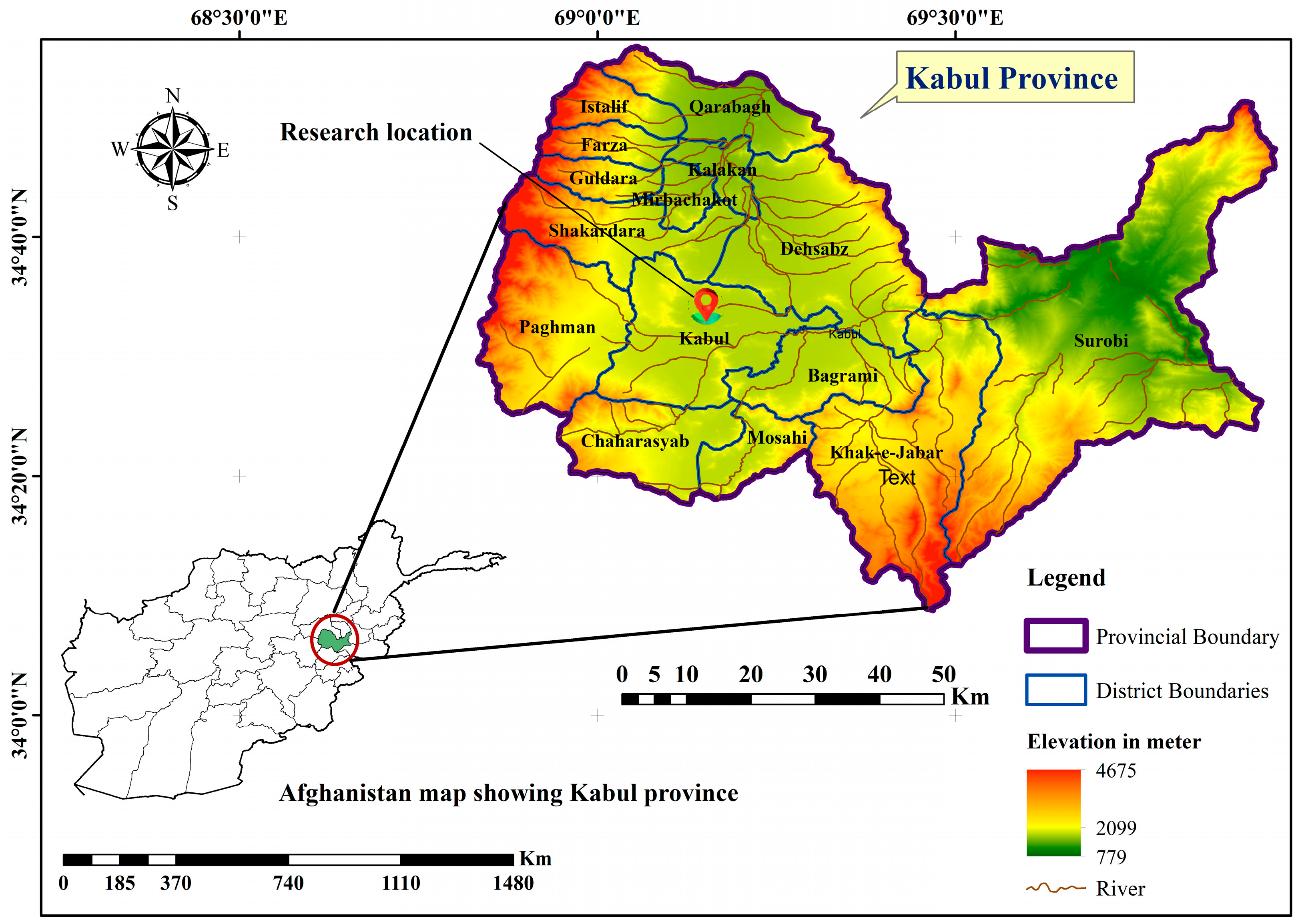
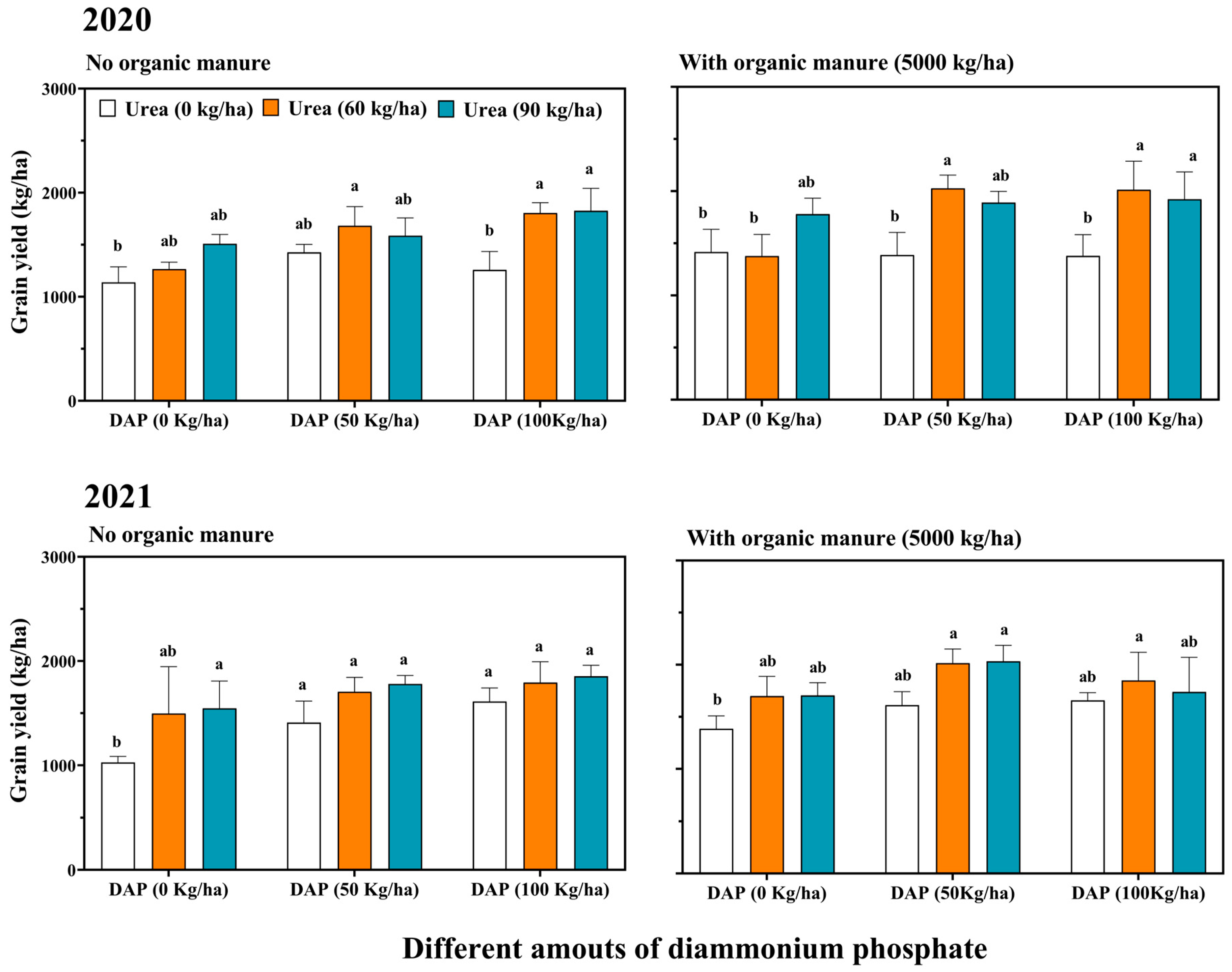
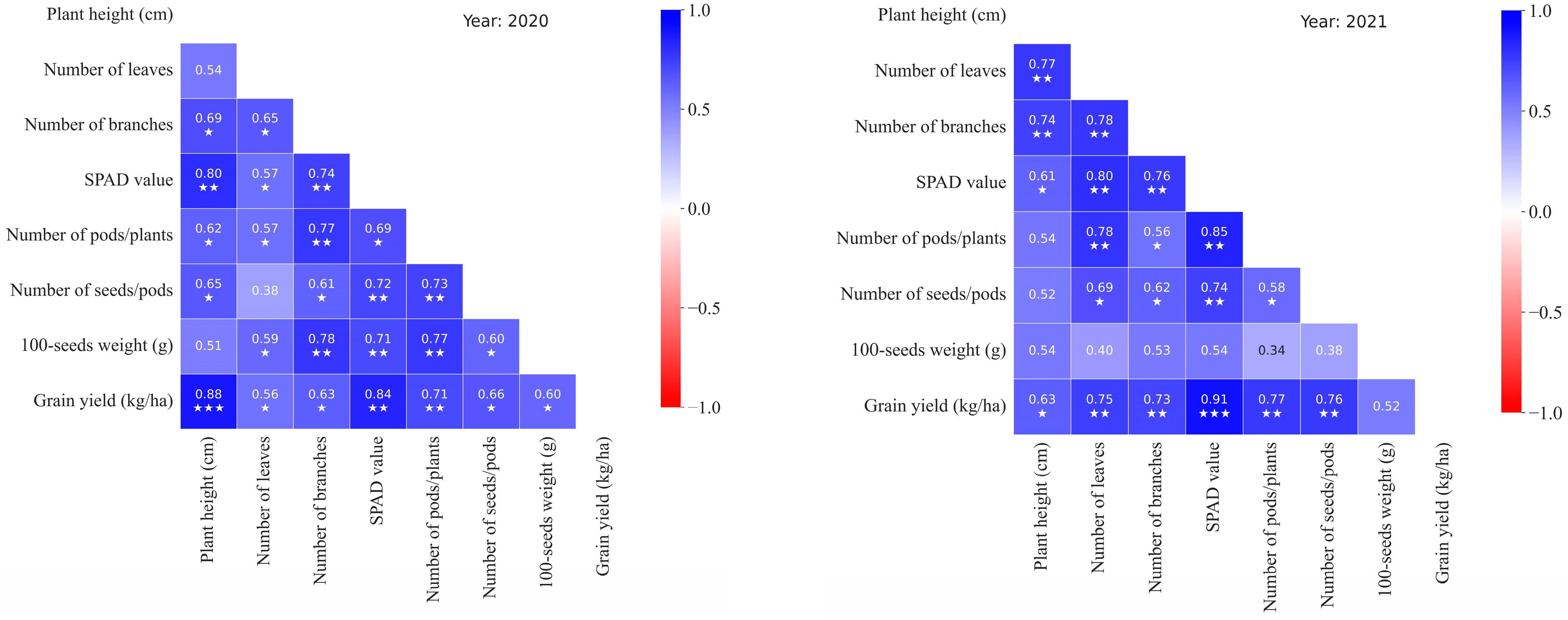
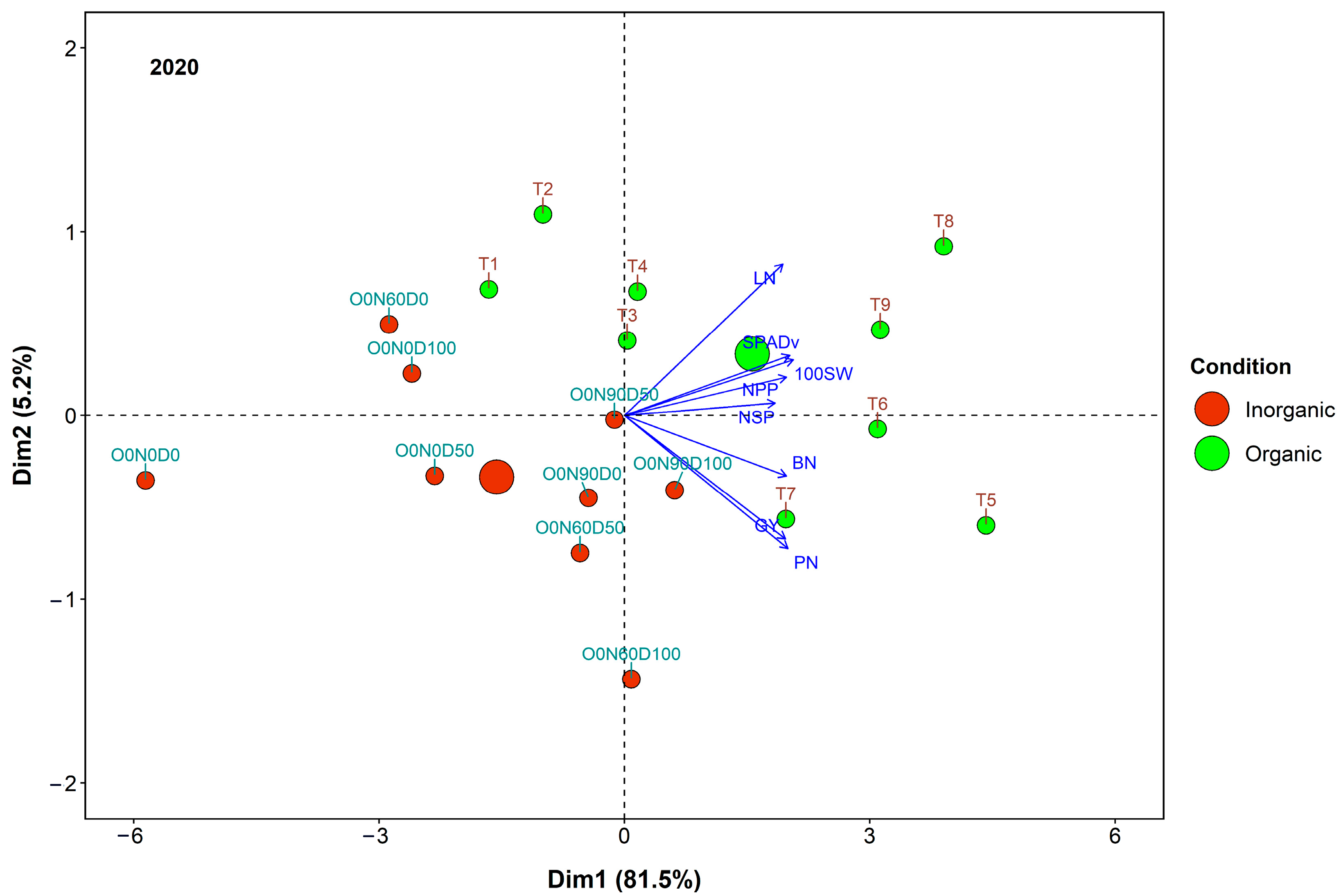
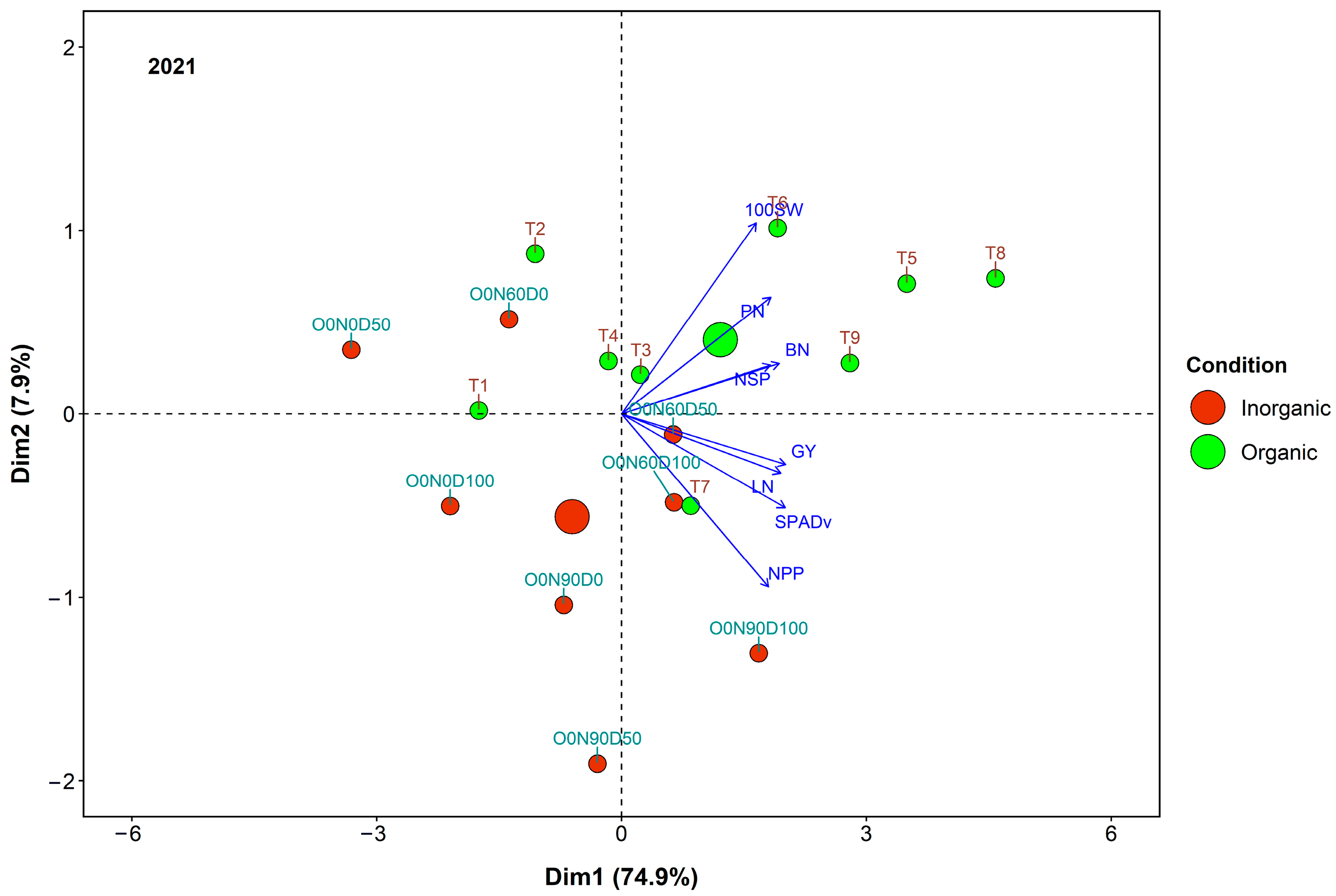
| Soil Characteristics | Amount |
|---|---|
| pH | 8.2 |
| EC (dS/cm) | 17.8 |
| Organic matter (%) | 0.7 |
| Nitrogen (ppm) | 8.9 |
| Phosphorus (ppm) | 8.7 |
| Potassium (ppm) | 73.2 |
| Calcium carbonate (CaCO3, %) | 15.1 |
| Sulfur (ppm) | 7.1 |
| Magnesium (ppm) | 11.2 |
| Soil texture | Silty loam |
| Organic Manure (kg/ha) | Urea (kg/ha) | DAP (kg/ha) | Plant Height (cm) | Number of Leaves | Number of Branches | SPAD Value | ||||
|---|---|---|---|---|---|---|---|---|---|---|
| 2020 | 2021 | 2020 | 2021 | 2020 | 2021 | 2020 | 2021 | |||
| 0 | 0 | 0 | 39.2 ± 2.5 b† | 42.7 ± 2.5 b | 18.3 ± 2.6 b | 19.3 ± 1.5 b | 3.9 ± 1.3 b | 3.5 ± 0.6 b | 30.5 ± 1.7 d | 29.7 ± 1.5 c |
| 50 | 42.2 ± 3.1 ab | 43.1 ± 3.9 b | 20.3 ± 1.5 b | 20.2 ± 1.3 b | 4.7 ± 0.6 ab | 3.8 ± 0.7 b | 35.0 ± 2.6 bcd | 37.3 ± 2.1 b | ||
| 100 | 40.1 ± 2.6 ab | 43.7 ± 5.1 ab | 19.2 ± 2.1 b | 20.7 ± 0.8 ab | 4.8 ± 1.5 ab | 3.7 ± 0.5 b | 36.3 ± 1.9 abcd | 37.6 ± 1.5 ab | ||
| 60 | 0 | 40.0 ± 2.2 ab | 43.6 ± 5.3 ab | 19.8 ± 3.7 b | 20.1 ± 1.8 b | 4.7 ± 1.7 ab | 4.4 ± 0.5 ab | 36.2 ± 2.5 abcd | 37.0 ± 0.6 b | |
| 50 | 43.5 ± 4.5 ab | 44.6 ± 4.1 ab | 20.2 ± 0.8 b | 23.1 ± 2.3 ab | 5.1 ± 1.8 ab | 4.6 ± 1.1 ab | 36.9 ± 2.6 abc | 39.0 ± 1.1 ab | ||
| 100 | 44.7 ± 4.6 ab | 45.0 ± 1.5 ab | 20.1 ± 0.9 b | 22.3 ± 1.5 ab | 5.4 ± 0.7 ab | 4.9 ± 0.9 ab | 38.0 ± 2.0 abc | 39.3 ± 1.5 ab | ||
| 90 | 0 | 42.7 ± 0.6 ab | 43.7 ± 4.5 ab | 20.0 ± 1.0 b | 22.1 ± 1.7 ab | 5.6 ± 1.8 ab | 3.8 ± 1.1 b | 38.3 ± 2.1 abc | 39.2 ± 2.1 ab | |
| 50 | 42.1 ± 2.1 ab | 43.2 ± 1.9 b | 21.2 ± 1.5 b | 21.7 ± 2.7 ab | 5.3 ± 0.6 ab | 4.3 ± 1.2 ab | 39.1 ± 2.3 abc | 40.3 ± 1.5 ab | ||
| 100 | 43.3 ± 5.2 ab | 45.2 ± 6.6 ab | 21.2 ± 1.5 b | 23.4 ± 1.2 ab | 5.3 ± 0.6 ab | 4.8 ± 0.5 ab | 39.6 ± 2.5 abc | 41.6 ± 1.0 ab | ||
| 5000 | 0 | 0 | 41.5 ± 4.1 ab | 43.6 ± 2.1 ab | 21.1 ± 2.1 b | 20.3 ± 1.1 ab | 4.7 ± 0.8 ab | 4.3 ± 0.9 ab | 37.0 ± 1.2 abcd | 37.7 ± 1.0 ab |
| 50 | 41.3 ± 2.0 ab | 45.7 ± 3.8 ab | 21.3 ± 2.1 b | 21.3 ± 1.2 ab | 4.8 ± 1.1 ab | 4.2 ± 0.6 ab | 33.7 ± 1.0 cd | 37.3 ± 2.3 b | ||
| 100 | 43.6 ± 2.1 ab | 44.1 ± 5.4 ab | 21.2 ± 2.6 b | 22.3 ± 1.2 ab | 5.1 ± 0.2 ab | 4.9 ± 0.7 ab | 37.0 ± 1.6 abcd | 38.6 ± 1.0 ab | ||
| 60 | 0 | 42.4 ± 3.2 ab | 44.3 ± 4.6 ab | 21.3 ± 3.5 b | 21.7 ± 1.5 ab | 5.4 ± 1.4 ab | 4.5 ± 1.1 ab | 40.1 ± 2.5 abc | 39.0 ± 2.6 ab | |
| 50 | 46.6 ± 2.5‡ a | 45.5 ± 3.2 ab | 22.3 ± 1.5 ab | 23.3 ± 1.1 ab | 6.4 ± 1.3 a | 5.3 ± 0.5 a | 40.9 ± 2.6 abc | 42.1 ± 2.5 ab | ||
| 100 | 44.7 ± 1.4 a | 45.1 ± 5.1 ab | 21.9 ± 1.1 ab | 21.3 ± 1.2 ab | 5.4 ± 0.8 ab | 4.6 ± 0.6 ab | 41.2 ± 1.5 ab | 41.3 ± 2.1 ab | ||
| 90 | 0 | 45.2 ± 9.1 ab | 44.4 ± 3.5 ab | 21.2 ± 2.6 b | 22.7 ± 2.5 ab | 5.1 ± 1.9 ab | 4.8 ± 0.8 ab | 40.9 ± 1.5 abc | 41.3 ± 1.5 ab | |
| 50 | 44.7 ± 4.9 ab | 47.1 ± 2.2 a | 23.8 ± 1.4 a | 25.1 ± 2.0 a | 6.1 ± 1.2 a | 5.5 ± 0.6 a | 41.3 ± 2.1 ab | 42.6 ± 0.6 a | ||
| 100 | 44.7 ± 4.6 ab | 45.3 ± 4.7 ab | 22.3 ± 1.1 ab | 23.3 ± 2.6 ab | 5.3 ± 1.7 ab | 4.7 ± 0.6 ab | 41.9 ± 1.5 a | 42.0 ± 1.7 ab | ||
| Organic Manure (kg/ha) | Urea (kg/ha) | DAP (kg/ha) | Number of Pods/Plants | Number of Seeds/Pods | 100-Seeds Weight (g) | |||
|---|---|---|---|---|---|---|---|---|
| 2020 | 2021 | 2020 | 2021 | 2020 | 2021 | |||
| 0 | 0 | 0 | 55.6 ± 5.1 c | 44.6 ± 5.2 c | 3.0 ± 0.1 b | 3.3 ± 0.4 b | 45.8 ± 1.9 b | 44.1 ± 2.6 b |
| 50 | 59.7 ± 3.5 abc | 46.8 ± 6.8 bc | 3.5 ± 0.3 ab | 3.4 ± 0.4 b | 47.1 ± 1.5 ab | 46.1 ± 1.5 ab | ||
| 100 | 63.3 ± 9.8 abc | 57.7 ± 2.7 abc | 3.6 ± 0.4 ab | 3.7 ± 0.2 ab | 47.7 ± 2.3 ab | 46.0 ± 1.2 ab | ||
| 60 | 0 | 59.1 ± 1.5 bc | 52.8 ± 10.5 abc | 3.3 ± 0.9 ab | 4.3 ± 0.9 ab | 48.1 ± 3.2 ab | 46.4 ± 2.5 ab | |
| 50 | 66.1 ± 11.9 abc | 61.2 ± 5.7 abc | 3.5 ± 0.2 ab | 4.3 ± 0.5 ab | 49.0 ± 3.2 ab | 47.2 ± 3.2 ab | ||
| 100 | 64.7 ± 11.1 abc | 64.3 ± 4.5 abc | 3.5 ± 0.2 ab | 3.9 ± 0.3 ab | 48.9 ± 3.1 ab | 46.4 ± 2.1 ab | ||
| 90 | 0 | 65.1 ± 10.5 abc | 65.1 ± 11.3 abc | 3.5 ± 0.3 ab | 4.2 ± 0.2 ab | 49.2 ± 4.3 ab | 46.3 ± 3.1 ab | |
| 50 | 65.0 ± 7.6 abc | 68.3 ± 7.2 a | 3.6 ± 0.3 ab | 3.8 ± 0.2 ab | 49.3 ± 6.1 ab | 45.6 ± 1.5 ab | ||
| 100 | 64.4 ± 3.7 abc | 68.1 ± 3.3 a | 4.0 ± 0.8 ab | 4.3 ± 0.1 ab | 48.6 ± 3.3 ab | 45.3 ± 2.1 ab | ||
| 5000 | 0 | 0 | 68.3 ± 15.3 abc | 62.6 ± 4.6 abc | 3.1 ± 0.3 b | 3.5 ± 0.9 b | 48.2 ± 2.1 ab | 48.2 ± 2.1 ab |
| 50 | 63.7 ± 8.1 abc | 55.4 ± 4.9 abc | 3.5 ± 0.1 ab | 3.9 ± 0.6 b | 49.2 ± 1.2 ab | 46.7 ± 2.5 ab | ||
| 100 | 72.5 ± 5.5 abc | 60.6 ± 8.3 abc | 3.8 ± 0.1 ab | 4.0 ± 0.2 ab | 49.3 ± 0.7 ab | 48.3 ± 2.5 ab | ||
| 60 | 0 | 66.4 ± 7.2 abc | 55.4 ± 4.9 abc | 4.1 ± 0.3 ab | 4.4 ± 0.8 ab | 48.2 ± 3.1 ab | 46.7 ± 3.5 ab | |
| 50 | 87.0 ± 2.6 a | 66.3 ± 5.5 ab | 4.1 ± 0.2 ab | 4.7 ± 0.4 a | 51.1 ± 1.4 a | 51.2 ± 1.4 ab | ||
| 100 | 76.7 ± 5.7 abc | 62.7 ± 5.5 abc | 4.4 ± 0.1 a | 4.6 ± 0.3 a | 50.8 ± 1.1 a | 51.3 ± 1.0 a | ||
| 90 | 0 | 69.1 ± 5.8 abc | 61.6 ± 6.6 abc | 4.0 ± 1.0 ab | 4.3 ± 0.2 ab | 50.1 ± 5.3 ab | 46.6 ± 1.5 ab | |
| 50 | 78.9 ± 6.6 ab | 68.8 ± 10.1 a | 3.9 ± 0.2 ab | 4.4 ± 0.3 ab | 52.1 ± 1.7 a | 51.3 ± 1.9 a | ||
| 100 | 77.2 ± 9.3 abc | 69.1 ± 5.0 a | 4.2 ± 0.3 ab | 4.5 ± 0.7 ab | 51.5 ± 2.1 a | 51.3 ± 1.5 a | ||
Disclaimer/Publisher’s Note: The statements, opinions and data contained in all publications are solely those of the individual author(s) and contributor(s) and not of MDPI and/or the editor(s). MDPI and/or the editor(s) disclaim responsibility for any injury to people or property resulting from any ideas, methods, instructions or products referred to in the content. |
© 2025 by the authors. Licensee MDPI, Basel, Switzerland. This article is an open access article distributed under the terms and conditions of the Creative Commons Attribution (CC BY) license (https://creativecommons.org/licenses/by/4.0/).
Share and Cite
Habibi, S.; Aryan, S.; Seerat, A.Y.; Saighani, K.; Haidari, M.D. Maximizing Common Bean (Phaseolus vulgaris L.) Productivity Through Application of Organic and Inorganic Fertilizers in Alkaline Soil. Appl. Biosci. 2025, 4, 22. https://doi.org/10.3390/applbiosci4020022
Habibi S, Aryan S, Seerat AY, Saighani K, Haidari MD. Maximizing Common Bean (Phaseolus vulgaris L.) Productivity Through Application of Organic and Inorganic Fertilizers in Alkaline Soil. Applied Biosciences. 2025; 4(2):22. https://doi.org/10.3390/applbiosci4020022
Chicago/Turabian StyleHabibi, Safiullah, Shafiqullah Aryan, Ali Yawar Seerat, Kalimullah Saighani, and Mohammad Daud Haidari. 2025. "Maximizing Common Bean (Phaseolus vulgaris L.) Productivity Through Application of Organic and Inorganic Fertilizers in Alkaline Soil" Applied Biosciences 4, no. 2: 22. https://doi.org/10.3390/applbiosci4020022
APA StyleHabibi, S., Aryan, S., Seerat, A. Y., Saighani, K., & Haidari, M. D. (2025). Maximizing Common Bean (Phaseolus vulgaris L.) Productivity Through Application of Organic and Inorganic Fertilizers in Alkaline Soil. Applied Biosciences, 4(2), 22. https://doi.org/10.3390/applbiosci4020022







